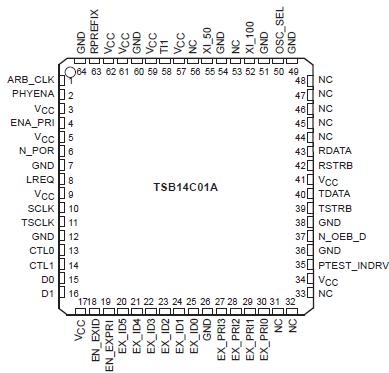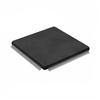Features: `Supports Provisions of IEEE 1394-1995 (1394) Standard for High-Performance Serial Bus†
`Fully Interoperable With FireWireE Implementation of 1394
`Provides A Backplane Environment That Supports 50 or 100 Megabits per Second (Mbits/s)
`Logic Performs System Initialization and Arbitration Functions
`Encode and Decode Functions Included for Data-Strobe Bit-Level Encoding
`Incoming Data Resynchronized to Local Clock
`Separate Transmitter and Receiver for Greater Flexibility
`Data Interface to Link-Layer Controller (Link) Provided Through Two Parallel Signal Lines at 25/50 MHz
`100-MHz or 50-MHz Oscillator Provides Transmit, Receive-Data, and Link Clocks at 25/50 MHz
`Single 5-V Supply Operation
`Packaged in a High-Performance 64-Pin TQFP (PM) Package for 0°C to 70°C Operation and 40°C to 85°C Operation
`Packaged in a 68-Pin CFP (HV) Package for 55°C to 125°C OperationPinout Specifications
SpecificationsSupply voltage range, VCC . . . . . . . . . . . . . . . . . . . . . . . . . . . . . . . . . . . .0.5 V to 6.0 V
Input voltage range, VI . . . . . . . . . . . . . . . . . . . . . . . . . . . . . . . . 0.5 V to VCC + 0.5 V
Output voltage range at any output, VO . . . . . . . . . . . . . . . . . . . 0.5 V to VCC + 0.5 V
Continuous total power dissipation . . . . . . . . . . . . . . . . . . See Dissipation Rating Table
Operating free air temperature, TA:TSB14C01A . . . . . . . . . . . . . . . . . . . . 0°C to 70°C
Operating free air temperature, TA:TSB14C01AI . . . . . . . . . . . . . . . . . .40°C to 85°C
Operating free air temperature, TA:TSB14C01AM . . . . . . . . . . . . . . . . 55°C to 125°C
Storage temperature range, Tstg . . . . . . . . . . . . . . . . . . . . . . . . . . . . 65°C to 150°C
Lead temperature 1,6 mm (1/16 inch) from case for 10 seconds . . . . . . . . . . . . . 300°C
† Stresses beyond those listed under "absolute maximum ratings" may cause permanent damage to the device. These are stress ratings only, and functional operation of the device at these or any other conditions beyond those indicated under "recommended operating conditions" is not implied. Exposure to absolute-maximum-rated conditions for extended periods may affect device reliability.
DescriptionThe TSB14C01A provides the transceiver functions needed to implement a single port node in a backplanebased 1394 network. The TSB14C01A provides two terminals for transmitting, two terminals for receiving, and a single terminal to externally control the drivers for data and strobe. The TSB14C01A is not designed to drive the backplane directly, this function must be provided externally. The TSB14C01A is designed to interface with a link-layer controller (link), such as the TSB12C01A.
The TSB14C01A requires an external 98.304-MHz or 49.152-MHz reference oscillator input for S100/50 operation. The reference signal is internally divided to provide the 49.152-MHz ±100-ppm system clock signals used to control transmission of the outbound encoded strobe and data information. The 49.152-MHz clock signal is supplied to the associated link for synchronization of the two chips. When this device is in the S100 mode of operation, OSC_SEL is asserted high. When the TSB14C01A is in the S50 mode of operation, the clock rate supplied to the link is 24.576 MHz.
Data bits to be transmitted are received from the link on two parallel paths and are latched internally in the TSB14C01A in synchronization with the 49.152-MHz system clock. These bits are combined serially, encoded, and then transmitted at 98.304-Mbits/s (in S100 mode) as the outbound data-strobe information stream. During transmission, the encoded data information is transmitted on TDATA, and the encoded strobe information is transmitted on TSTRB. During packet reception the encoded information is received on RDATA and strobe information on RSTRB.
The received data-strobe information is decoded to recover the receive clock signal and the serial data bits. The serial data bits are split into two parallel streams, resynchronized to the local system clock, and sent to the associated link.

 TSB14C01A Data Sheet
TSB14C01A Data Sheet








